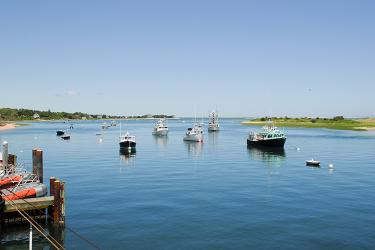Around the Northeast and throughout the country, aging dams are being removed to improve public safety and restore river and coastal ecosystems. Originally built for everything from providing power for mills to flood control, many of these older dams have outlived their usefulness as technology has advanced. Dam removal in coastal watersheds opens access to spawning and rearing habitats for migratory fish. More than a dozen marine fish species, including Atlantic salmon, river herring, and American shad, need freshwater habitats to complete one or more life cycle stages. Today, there are still thousands of dams that impede these migrations.
Dams function by blocking water flow. They transform rivers immediately upstream into pond-like environments called “reservoirs” or “impoundments.” These reservoirs trap river sediments that travel from further upstream. Sediments (e.g., gravel, sand, silt, and clay) can accumulate over time in the reservoir. At the same time, rivers downstream of dams continue to transport the sediments that compose their channel beds without resupply of sediments from upstream, so they erode and become coarser.
One way to address these concerns is to remove the stored sediments from the reservoir area before removing the dam. Removal is usually required when sediments are contaminated. But if the sediments are clean, dredging makes the project much more expensive and time consuming—sometimes prohibitively so. Dredging can also be impractical if the reservoir area is large and the upstream watershed delivers new sediment faster than the dredging rate. Also, dredging clean sediments can diminish a project benefit: returning sediments to downstream areas
deprived of them for decades because of the dam.
A research team led by the NOAA Restoration Center wanted to learn more about how river channels respond to dam removal sediment releases, particularly how long the effects last and how large the impacts are. The team compared channel measurements and sediment data from two of the longest running dam removal monitoring studies in the country: Merrimack Village Dam in New Hampshire and Simkins Dam in Maryland. They found that the two sites, where sediments eroded and moved downstream naturally, had similar upstream responses. They
proposed a model that describes the changes.
Erosion of the stored sediments happens in two phases. During the first phase, rapid erosion removes about 50 percent of the stored sediments in less than six months. Interestingly, the high magnitude and rate of erosion in this phase happens even during periods of low river flow. When about half of the sediments remain in the former reservoir, the second, and longer, phase begins. Additional erosion happens most often with floods. Downstream responses at the sites appear to depend on channel slopes and base flows. Large quantities of sediment never
persisted for long periods in the former reservoir areas or downstream channels of either site.
This information can help plan future dam removals and predict impacts. Read the paper online.



